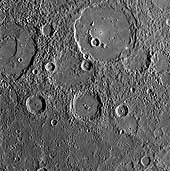|
COMETS EARTH JUPITER KUIPER BELT MARS MERCURY METEORITES NEPTUNE OORT CLOUD PLUTO SATURN SOLAR SYSTEM SPACE SUN URANUS VENUS ORDER PRINTS
PHOTO CATEGORIES SCIENCEVIEWS AMERICAN INDIAN AMPHIBIANS BIRDS BUGS FINE ART FOSSILS THE ISLANDS HISTORICAL PHOTOS MAMMALS OTHER PARKS PLANTS RELIGIOUS REPTILES SCIENCEVIEWS PRINTS
|
Related Documents
Download Options
Image Mission Elapsed Time (MET): 131770421 This WAC image was acquired 9 minutes and 14 seconds after MESSENGER's closest approach to Mercury, when the spacecraft was moving at 6.1 kilometers/second (3.8 miles/second). The image, centered at about 2.4°S, 290°E, is one in a sequence of 55: a five-frame mosaic with each frame in the mosaic acquired in all 11 of the WAC filters. This portion of Mercury's surface was previously imaged under different lighting conditions by Mariner 10, but this new MESSENGER image mosaic is the highest-resolution color imaging ever acquired of any portion of Mercury's surface. Additionally, some of the images in this mosaic overlap with flyby data acquired by the Mercury Atmospheric and Surface Composition Spectrometer (MASCS) and Mercury Laser Altimeter (MLA) instruments, resulting in the first time that these three instruments have gathered data of the same area of Mercury. The combination of these three datasets will enable unprecedented studies of this region of Mercury's surface. The largest impact feature at the top of the image is about 133 kilometers (83 miles) in diameter and is named Polygnotus, after a Greek painter from the 5th century B.C. This basin has a central peak ring and is embayed with smooth plains material, which is very different in texture from the surrounding terrain. A second, comparably large crater at the top left of the image, named Boethius after the 6th century Roman philosopher, also appears to be almost filled with smooth plains, which were subsequently deformed during the formation of a prominent scarp. |
